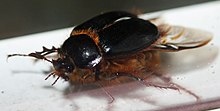Rain beetle
| Rain beetles Temporal range:
| |
|---|---|

| |
| Pleocoma | |
| Scientific classification | |
| Kingdom: | Animalia |
| Phylum: | Arthropoda |
| Class: | Insecta |
| Order: | Coleoptera |
| Suborder: | Polyphaga |
| Infraorder: | Scarabaeiformia |
| Superfamily: | Scarabaeoidea |
| Family: | Pleocomidae LeConte, 1861 |
| Genera | |
| |
The rain beetles are a group of beetles found in the far west of North America.[1] They spend most of their lives underground, emerging in response to rain or snow, thus the common name. Formerly classified in the Scarabaeidae (and later the Geotrupidae), they are currently assigned to their own family Pleocomidae, considered the sister group to all the remaining families of Scarabaeoidea. The family contains a single extant genus, Pleocoma, and two extinct genera, Cretocoma, described in 2002 from Late Cretaceous deposits in Mongolia,[2] and of Late Cretaceous China.[3]
Possessing a robust oval body form similar to other scarabaeiforms, their ventral side is densely covered with fine, long hairs (genus name derives from Greek πλείων (ple-, abundant) and κόμη (kome, hair), extending to the legs and to the margins of thorax and elytra. The back is hairless and glossy. Overall colors range from black to a reddish-brown, while the hairs may range from yellow to red to black. The antennae are 11-segmented, with a club of four to eight lamellae, more than in any other group of the Scarabaeoidea. The mandibles are not functional, and the opening into the esophagus is closed off; adults do not eat.[1]
Larvae have the typical scarabaeiform characteristics, C-shaped bodies generally a creamy white. They feed on roots in the soil, often deep beneath the host plant. Details of the larval stage are only known for some species; they have nine or more instars, and may take up to 13 years to mature. After a late summer pupation, adults of both sexes dig their way to the surface, emerging around the onset of the fall/winter rainy season typical of, for instance, California's climate; some species are active as late as early spring. Females have only vestigial wings, so the males fly around (often while it is raining), homing in on pheromones released by the females. They mate on the surface or in a burrow dug out by the female, then the female lays eggs in the bottom of the burrow. The "triggering" conditions required for some species to fly are so stringent that a given population may only be active for a single day in a given year. Males are commonly attracted to bright lights.[citation needed]
Members of Pleocoma are known from extreme southern Washington, throughout the mountains of Oregon and California, and into the extreme north of Baja California.[1]
References[]
- ^ a b c Hovore, Frank T. "Generic Guide to New World Scarab Beetles". unsm-ento.unl.edu. University of Nebraska State Museum - Division of Entomology. Retrieved 14 December 2020.
- ^ Frank-Thorsten Krell. "Catalogue of fossil Scarabaeoidea (Coleoptera: Polyphaga) of the Mesozoic and Tertiary" (PDF). Natural History Museum. Archived from the original (PDF) on July 20, 2011. Retrieved March 7, 2011.
- ^ Krell, Frank-Thorsten. "The fossil record of Mesozoic and Tertiary Scarabaeoidea (Coleoptera: Polyphaga)." Invertebrate Systematics 14.6 (2000): 871-905.
- Frank T. Hovore (2002). "Pleocomidae". In Ross H. Arnett, Jr.; Michael C. Thomas; Paul E. Skelley; J. Howard Frank (eds.). Volume 2: Polyphaga: Scarabaeoidea through Curculionoidea. American Beetles. CRC Press. pp. 20–22. ISBN 0-8493-0954-9.
External links[]
 Data related to Pleocomidae at Wikispecies
Data related to Pleocomidae at Wikispecies
- Scarabaeiformia